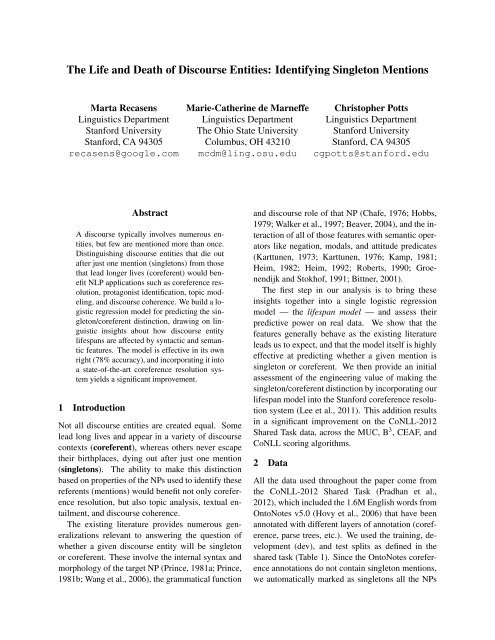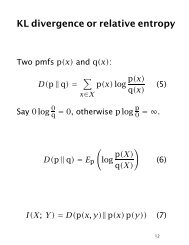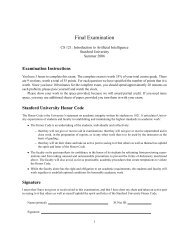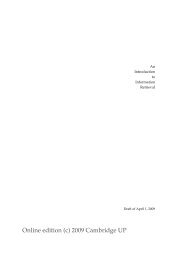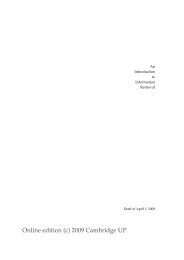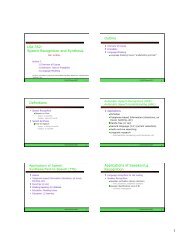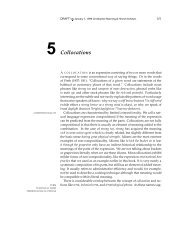The Life and Death of Discourse Entities: Identifying Singleton ...
The Life and Death of Discourse Entities: Identifying Singleton ...
The Life and Death of Discourse Entities: Identifying Singleton ...
Create successful ePaper yourself
Turn your PDF publications into a flip-book with our unique Google optimized e-Paper software.
<strong>The</strong> <strong>Life</strong> <strong>and</strong> <strong>Death</strong> <strong>of</strong> <strong>Discourse</strong> <strong>Entities</strong>: <strong>Identifying</strong> <strong>Singleton</strong> Mentions<br />
Marta Recasens<br />
Linguistics Department<br />
Stanford University<br />
Stanford, CA 94305<br />
recasens@google.com<br />
Abstract<br />
A discourse typically involves numerous entities,<br />
but few are mentioned more than once.<br />
Distinguishing discourse entities that die out<br />
after just one mention (singletons) from those<br />
that lead longer lives (coreferent) would benefit<br />
NLP applications such as coreference resolution,<br />
protagonist identification, topic modeling,<br />
<strong>and</strong> discourse coherence. We build a logistic<br />
regression model for predicting the singleton/coreferent<br />
distinction, drawing on linguistic<br />
insights about how discourse entity<br />
lifespans are affected by syntactic <strong>and</strong> semantic<br />
features. <strong>The</strong> model is effective in its own<br />
right (78% accuracy), <strong>and</strong> incorporating it into<br />
a state-<strong>of</strong>-the-art coreference resolution system<br />
yields a significant improvement.<br />
1 Introduction<br />
Not all discourse entities are created equal. Some<br />
lead long lives <strong>and</strong> appear in a variety <strong>of</strong> discourse<br />
contexts (coreferent), whereas others never escape<br />
their birthplaces, dying out after just one mention<br />
(singletons). <strong>The</strong> ability to make this distinction<br />
based on properties <strong>of</strong> the NPs used to identify these<br />
referents (mentions) would benefit not only coreference<br />
resolution, but also topic analysis, textual entailment,<br />
<strong>and</strong> discourse coherence.<br />
<strong>The</strong> existing literature provides numerous generalizations<br />
relevant to answering the question <strong>of</strong><br />
whether a given discourse entity will be singleton<br />
or coreferent. <strong>The</strong>se involve the internal syntax <strong>and</strong><br />
morphology <strong>of</strong> the target NP (Prince, 1981a; Prince,<br />
1981b; Wang et al., 2006), the grammatical function<br />
Marie-Catherine de Marneffe<br />
Linguistics Department<br />
<strong>The</strong> Ohio State University<br />
Columbus, OH 43210<br />
mcdm@ling.osu.edu<br />
Christopher Potts<br />
Linguistics Department<br />
Stanford University<br />
Stanford, CA 94305<br />
cgpotts@stanford.edu<br />
<strong>and</strong> discourse role <strong>of</strong> that NP (Chafe, 1976; Hobbs,<br />
1979; Walker et al., 1997; Beaver, 2004), <strong>and</strong> the interaction<br />
<strong>of</strong> all <strong>of</strong> those features with semantic operators<br />
like negation, modals, <strong>and</strong> attitude predicates<br />
(Karttunen, 1973; Karttunen, 1976; Kamp, 1981;<br />
Heim, 1982; Heim, 1992; Roberts, 1990; Groenendijk<br />
<strong>and</strong> Stokh<strong>of</strong>, 1991; Bittner, 2001).<br />
<strong>The</strong> first step in our analysis is to bring these<br />
insights together into a single logistic regression<br />
model — the lifespan model — <strong>and</strong> assess their<br />
predictive power on real data. We show that the<br />
features generally behave as the existing literature<br />
leads us to expect, <strong>and</strong> that the model itself is highly<br />
effective at predicting whether a given mention is<br />
singleton or coreferent. We then provide an initial<br />
assessment <strong>of</strong> the engineering value <strong>of</strong> making the<br />
singleton/coreferent distinction by incorporating our<br />
lifespan model into the Stanford coreference resolution<br />
system (Lee et al., 2011). This addition results<br />
in a significant improvement on the CoNLL-2012<br />
Shared Task data, across the MUC, B 3 , CEAF, <strong>and</strong><br />
CoNLL scoring algorithms.<br />
2 Data<br />
All the data used throughout the paper come from<br />
the CoNLL-2012 Shared Task (Pradhan et al.,<br />
2012), which included the 1.6M English words from<br />
OntoNotes v5.0 (Hovy et al., 2006) that have been<br />
annotated with different layers <strong>of</strong> annotation (coreference,<br />
parse trees, etc.). We used the training, development<br />
(dev), <strong>and</strong> test splits as defined in the<br />
shared task (Table 1). Since the OntoNotes coreference<br />
annotations do not contain singleton mentions,<br />
we automatically marked as singletons all the NPs
MENTIONS<br />
Dataset Docs Tokens Coreferent <strong>Singleton</strong>s<br />
Training 2,802 1.3M 152,828 192,248<br />
Dev 343 160K 18,815 24,170<br />
Test 348 170K 19,392 24,921<br />
Table 1: CoNLL-2012 Shared Task data statistics. We<br />
added singletons (NPs not annotated as coreferent).<br />
not annotated as coreferent. Thus, our singletons include<br />
non-referential NPs but not verbal mentions.<br />
3 Predicting lifespans<br />
Our lifespan model makes a binary distinction between<br />
discourse referents that are not part <strong>of</strong> a coreference<br />
chain (singletons) <strong>and</strong> items that are part <strong>of</strong><br />
one (coreferent). <strong>The</strong> distribution <strong>of</strong> lifespans in our<br />
data (Figure 1) suggests that this is a natural division.<br />
<strong>The</strong> propensity <strong>of</strong> singletons also highlights<br />
the relevance <strong>of</strong> detecting singletons for a coreference<br />
system. We fit a binary logistic regression<br />
model in R (R Core Team, 2012) on the training<br />
data, coding singletons as “0” <strong>and</strong> coreferent mentions<br />
as “1”. Throughout the following tables <strong>of</strong> coefficient<br />
estimates, positive values favor coreferents<br />
<strong>and</strong> negative ones favor singletons. We turn now to<br />
describing <strong>and</strong> motivating the features <strong>of</strong> this model.<br />
0 5K 15K 25K<br />
<strong>Singleton</strong> 2 3 4 5 6-10 11-15 16-20 >20<br />
Figure 1: Distribution <strong>of</strong> lifespans in the dev set. <strong>Singleton</strong>s<br />
account for 56% <strong>of</strong> the data.<br />
Internal morphosyntax <strong>of</strong> the mention Table 2<br />
summarizes the features from our model that concern<br />
the internal morphology <strong>and</strong> syntactic structure<br />
<strong>of</strong> the mention. Many are common in coreference<br />
systems (Recasens <strong>and</strong> Hovy, 2009), but our model<br />
highlights their influence on lifespans. <strong>The</strong> picture<br />
is expected on the taxonomy <strong>of</strong> given <strong>and</strong> new defined<br />
by Prince (1981b) <strong>and</strong> assumed throughout dynamic<br />
semantics (Kamp, 1981; Heim, 1982): pronouns<br />
depend on anaphoric connections to previous<br />
mentions for disambiguation <strong>and</strong> thus are very likely<br />
to be coreferent. This is corroborated by the positive<br />
coefficient estimate for ‘Type = pronoun’ in<br />
Table 2. Few quantified phrases easily participate<br />
in discourse anaphora (Partee, 1987; Wang et al.,<br />
2006), accounting for the association between quantifiers<br />
<strong>and</strong> singletons (negative coefficient estimate<br />
for ‘Quantifier = quantified’ in Table 2). <strong>The</strong> one<br />
surprise is the negative coefficient for indefinites. In<br />
theories stretching back to Karttunen (1976), indefinites<br />
function primarily to establish new discourse<br />
entities, <strong>and</strong> should be able to participate in coreference<br />
chains, but here the association with such<br />
chains is negative. However, interactions explain<br />
this fact (see Table 4 <strong>and</strong> our discussion <strong>of</strong> it).<br />
<strong>The</strong> person, number, <strong>and</strong> animacy values suggest<br />
that singular animates are excellent coreferent NPs,<br />
a previous finding <strong>of</strong> Centering <strong>The</strong>ory (Grosz et al.,<br />
1995; Walker et al., 1998) <strong>and</strong> <strong>of</strong> cross-linguistic<br />
work on obviative case-marking (Aissen, 1997).<br />
Our model also includes named-entity features for<br />
all <strong>of</strong> the eighteen OntoNotes entity-types (omitted<br />
from Table 2 for space <strong>and</strong> clarity reasons). As a<br />
rule, they behave like ‘Type = proper noun’ in associating<br />
with coreferents. <strong>The</strong> exceptions are ORDI-<br />
NAL, PERCENT, <strong>and</strong> QUANTITY, which seem intuitively<br />
unlikely to participate in coreference chains.<br />
Estimate P-value<br />
Type = pronoun 1.21 < 0.001<br />
Type = proper noun 1.88 < 0.001<br />
Animacy = inanimate −1.36 < 0.001<br />
Animacy = unknown −0.38 < 0.001<br />
Person = 1 1.05 < 0.001<br />
Person = 2 0.13 < 0.001<br />
Person = 3 1.62 < 0.001<br />
Number = singular 0.61 < 0.001<br />
Number = unknown 0.17 < 0.001<br />
Quantifier = indefinite −1.49 < 0.001<br />
Quantifier = quantified −1.23 < 0.001<br />
Number <strong>of</strong> modifiers −0.39 < 0.001<br />
Table 2: Internal morphosyntactic features.<br />
Grammatical role <strong>of</strong> the mention Synthesizing<br />
much work in Centering <strong>The</strong>ory <strong>and</strong> information<br />
structuring, we conclude that coreferent mentions<br />
are likely to appear as core verbal arguments <strong>and</strong><br />
will favor sentence-initial (topic-tracking) positions<br />
(Ward <strong>and</strong> Birner, 2004). <strong>The</strong> coefficient estimates
Estimate P-value<br />
Sentence Position = end −0.22 < 0.001<br />
Sentence Position = first 0.04 0.07<br />
Sentence Position = last −0.31 < 0.001<br />
Sentence Position = middle −0.11 < 0.001<br />
Relation = noun argument 0.56 < 0.001<br />
Relation = other −0.67 < 0.001<br />
Relation = root −0.61 < 0.001<br />
Relation = subject 0.65 < 0.001<br />
Relation = verb argument 0.32 < 0.001<br />
In coordination −0.48 < 0.001<br />
Table 3: Grammatical role features.<br />
in Table 3 corroborate these conclusions. To define<br />
the ‘Relation’ <strong>and</strong> ‘In coordination’ features, we<br />
used the Stanford dependencies (de Marneffe et al.,<br />
2006) on the gold constituents.<br />
Semantic environment <strong>of</strong> the mention Table 4<br />
highlights the complex interactions between discourse<br />
anaphora <strong>and</strong> semantic operators. <strong>The</strong>se<br />
interactions have been a focus <strong>of</strong> logical semantics<br />
since Karttunen (1976), whose guiding observation<br />
is semantic: an indefinite interpreted inside<br />
the scope <strong>of</strong> a negation, modal, or attitude predicate<br />
is generally unavailable for anaphoric reference outside<br />
<strong>of</strong> the scope <strong>of</strong> that operator, as in Kim didn’t<br />
underst<strong>and</strong> [an exam question]i. # Iti was too hard.<br />
Of course, such discourses cohere if the indefinite<br />
is interpreted as taking wide scope (‘there is a question<br />
Kim didn’t underst<strong>and</strong>’). Such readings are <strong>of</strong>ten<br />
disfavored, but they become more salient when<br />
modifiers like certain are included (Schwarzschild,<br />
2002) or when the determiner is sensitive to the polarity<br />
or intensionality <strong>of</strong> its environment (Baker,<br />
1970; Ladusaw, 1980; van der Wouden, 1997; Israel,<br />
1996; Israel, 2001; Giannakidou, 1999). Subsequent<br />
research identified many other factors that<br />
further extend or restrict the anaphoric potential <strong>of</strong><br />
an indefinite (Roberts, 1996).<br />
We do not have direct access to semantic scope,<br />
but we expect syntactic scope to correlate strongly<br />
with semantic scope, so we used dependency representations<br />
to define features capturing syntactic<br />
scope for negation, modal auxiliaries, <strong>and</strong> a broad<br />
range <strong>of</strong> attitude predicates. <strong>The</strong>se features tend to<br />
bias in favor <strong>of</strong> singletons because they so radically<br />
restrict the possibilities for intersentential anaphora.<br />
Interacting these features with those for the internal<br />
syntax <strong>of</strong> mentions is also informative. Since<br />
proper names <strong>and</strong> pronouns are not scope-taking,<br />
they are largely unaffected by the environment features,<br />
whereas indefinites emerge as even more restricted,<br />
just as Karttunen <strong>and</strong> others would predict.<br />
Attitude predicates seem initially anomalous,<br />
though. <strong>The</strong>y share the relevant semantic properties<br />
with negation <strong>and</strong> modals, <strong>and</strong> yet they seem<br />
to facilitate coreference. Here, the findings <strong>of</strong> de<br />
Marneffe et al. (2012) seem informative. Those authors<br />
find that, in texts <strong>of</strong> the sort we are studying,<br />
attitude predicates are used predominantly to mark<br />
the source <strong>of</strong> information that is effectively asserted<br />
despite being embedded (Rooryck, 2001; Simons,<br />
2007). That is, though X said p does not semantically<br />
entail p, it is <strong>of</strong>ten interpreted as a commitment<br />
to p, which correspondingly elevates mentions in p<br />
to main-clause status (Harris <strong>and</strong> Potts, 2009).<br />
Estimate P-value<br />
Presence <strong>of</strong> negation −0.18 < 0.001<br />
Presence <strong>of</strong> modality −0.22 < 0.001<br />
Under an attitude verb 0.03 0.01<br />
AttitudeVerb * (Type = pronoun) 0.29 < 0.001<br />
AttitudeVerb * (Type = proper noun) 0.14 < 0.001<br />
Modal * (Type = pronoun) 0.12 0.04<br />
Modal * (Type = proper noun) 0.35 < 0.001<br />
Negation * (Type = pronoun) 1.07 < 0.001<br />
Negation * (Type = proper noun) 0.30 < 0.001<br />
Negation * (Quantifier = indefinite) −0.37 < 0.001<br />
Negation * (Quantifier = quantified) −0.36 0.23<br />
Negation * (Number <strong>of</strong> modifiers) 0.11 < 0.001<br />
Table 4: Semantic environment features <strong>and</strong> interactions.<br />
Results <strong>The</strong> model successfully learns to tease<br />
singletons <strong>and</strong> coreferent mentions apart. Table 5<br />
summarizes its performance on the dev set. <strong>The</strong><br />
STANDARD model uses 0.5 as the decision boundary,<br />
with 78% accuracy. <strong>The</strong> CONFIDENT model<br />
predicts singleton if Pr < .2 <strong>and</strong> coreferent if Pr > .8,<br />
which increases precision (P) at a cost to recall (R).<br />
STANDARD CONFIDENT<br />
Prediction R P F1 R P F1<br />
<strong>Singleton</strong> 82.3 79.2 80.7 50.5 89.6 64.6<br />
Coreferent 72.2 76.1 74.1 41.3 86.8 55.9<br />
Table 5: Recall, precision, <strong>and</strong> F1 for the lifespan model.
MUC B 3 CEAF-φ3 CEAF-φ4 CoNLL<br />
System R P F1 R P F1 R / P / F1 R P F1 F1<br />
Baseline 66.64* 64.72 65.67 68.05* 71.58 69.77* 58.31 45.49 47.55* 46.50 60.65<br />
w/ <strong>Life</strong>span 66.08 67.33* 66.70* 66.40 73.14* 69.61 58.83* 47.77* 46.38 47.07* 61.13*<br />
Table 6: Performance on the test set according to the <strong>of</strong>ficial CoNLL-2012 scorer. Scores are on automatically predicted<br />
mentions. Stars indicate a statistically significant difference (paired Mann-Whitney U-test, p < 0.05).<br />
B 3 CEAF-φ3 CoNLL<br />
System R P F1 R P F1 F1<br />
Baseline 58.53* 71.58 64.40 63.71* 58.31 60.89 58.86<br />
w/ <strong>Life</strong>span 58.14 73.14* 64.78* 63.38 58.83* 61.02 59.52*<br />
Table 7: B 3 , CEAF-φ3 <strong>and</strong> CoNLL measures on the test set according to a modified CoNLL-2012 scorer that follows<br />
Cai <strong>and</strong> Strube (2010). Scores are on automatically predicted mentions.<br />
4 Application to coreference resolution<br />
To assess the usefulness <strong>of</strong> the lifespan model in an<br />
NLP application, we incorporate it into the Stanford<br />
coreference resolution system (Lee et al., 2011),<br />
which we take as our baseline. This was the highestscoring<br />
system in the CoNLL-2011 Shared Task,<br />
<strong>and</strong> was also part <strong>of</strong> the highest-scoring system in<br />
the CoNLL-2012 Shared Task (Fern<strong>and</strong>es et al.,<br />
2012). It is a rule-based system that includes a total<br />
<strong>of</strong> ten rules (or “sieves”) for entity coreference,<br />
such as exact string match <strong>and</strong> pronominal resolution.<br />
<strong>The</strong> sieves are applied from highest to lowest<br />
precision, each rule adding coreference links.<br />
Incorporating the lifespan model <strong>The</strong> lifespan<br />
model can improve coreference resolution in two<br />
different ways: (i) mentions classified as singletons<br />
should not be considered as either antecedents or<br />
coreferent, <strong>and</strong> (ii) mentions classified as coreferent<br />
should be linked with another mention(s). By successfully<br />
predicting singletons (i), we can enhance<br />
the system’s precision; by successfully predicting<br />
coreferent mentions (ii), we can improve the system’s<br />
recall. Here we focus on (i) <strong>and</strong> use the lifespan<br />
model for detecting singletons. This decision<br />
is motivated by two factors. First, given the large<br />
number <strong>of</strong> singletons (Figure 1), we are more likely<br />
to see a gain in performance from discarding singletons.<br />
Second, the multi-sieve nature <strong>of</strong> the Stanford<br />
coreference system does not make it straightforward<br />
to decide which antecedent a mention should<br />
be linked to even if we know that it is coreferent.<br />
We leave the incorporation <strong>of</strong> coreferent predictions<br />
for future work.<br />
To integrate the singleton model into the Stanford<br />
coreference system, we let a sieve consider whether<br />
a pair <strong>of</strong> mentions is coreferent only if neither <strong>of</strong><br />
the two mentions are classified as singletons by our<br />
CONFIDENT model. Experiments on the dev set<br />
showed that the model <strong>of</strong>ten made wrong predictions<br />
for NEs. We do not trust the model for NE<br />
mentions. Performance on coreference (on the dev<br />
set) was higher with the CONFIDENT model than<br />
with the STANDARD model.<br />
Results <strong>and</strong> discussion To evaluate the coreference<br />
system with <strong>and</strong> without the lifespan model, we<br />
used the English dev <strong>and</strong> test sets from the CoNLL-<br />
2012 Shared Task, presented in Section 2. Although<br />
the CoNLL shared task evaluated systems on only<br />
multi-mention (i.e., non-singleton) entities, by stopping<br />
singletons from being linked to multi-mention<br />
entities, we expected the lifespan model to increase<br />
the system’s precision. Our evaluation uses five<br />
<strong>of</strong> the measures given by the CoNLL-2012 scorer:<br />
MUC (Vilain et al., 1995), B 3 (Bagga <strong>and</strong> Baldwin,<br />
1998), CEAF-φ3 <strong>and</strong> CEAF-φ4 (Luo, 2005), <strong>and</strong> the<br />
CoNLL <strong>of</strong>ficial score (Denis <strong>and</strong> Baldridge, 2009).<br />
We do not include BLANC (Recasens <strong>and</strong> Hovy,<br />
2011) because it assumes gold mentions <strong>and</strong> so is<br />
not suited for the scenario considered in this paper,<br />
which uses automatically predicted mentions.<br />
Table 6 summarizes the test set performance. All<br />
the scores are on automatically predicted mentions.<br />
We use gold POS, parse trees, <strong>and</strong> NEs. <strong>The</strong> base-
line is the Stanford system, <strong>and</strong> ‘w/ <strong>Life</strong>span’ is the<br />
same system extended with our lifespan model to<br />
discard singletons, as explained above.<br />
As expected, the lifespan model increases precision<br />
but decreases recall. Overall, however, we obtain<br />
a significant improvement <strong>of</strong> 0.5–1 points in the<br />
F1 score <strong>of</strong> MUC, CEAF-φ3, CEAF-φ4 <strong>and</strong> CoNLL.<br />
<strong>The</strong> drop in B 3 traces to a bug in the CoNLL scorer’s<br />
implementation <strong>of</strong> Cai <strong>and</strong> Strube (2010)’s algorithm<br />
for aligning gold <strong>and</strong> automatically predicted<br />
mentions, which affects the computation <strong>of</strong> B 3 <strong>and</strong><br />
CEAF-φ3. 1 Table 7 presents the results after modifying<br />
the CoNLL-2012 scorer to compute B 3 <strong>and</strong><br />
CEAF-φ3 according to Cai <strong>and</strong> Strube (2010). 2 We<br />
do see an improvement in the precision <strong>and</strong> F1<br />
scores <strong>of</strong> B 3 , <strong>and</strong> the overall CoNLL score remains<br />
significant. <strong>The</strong> CEAF-φ3 F1 score is no longer significant,<br />
but is still in the expected direction.<br />
5 Conclusion<br />
We built a model to predict the lifespan <strong>of</strong> discourse<br />
referents, teasing apart singletons from coreferent<br />
mentions. <strong>The</strong> model validates existing linguistic<br />
insights <strong>and</strong> performs well in its own right. This<br />
alone has ramifications for tracking topics, identifying<br />
protagonists, <strong>and</strong> modeling coreference <strong>and</strong> discourse<br />
coherence. We applied the lifespan model to<br />
coreference resolution, showing how to incorporate<br />
it effectively into a state-<strong>of</strong>-the-art rule-based coreference<br />
system. We expect similar improvements<br />
with machine-learning-based coreference systems,<br />
where incorporating all the power <strong>of</strong> the lifespan<br />
model would be easier.<br />
Our lifespan model has been integrated into the<br />
latest version <strong>of</strong> the Stanford coreference resolution<br />
system. 3<br />
1 At present, if the system links two mentions that do not<br />
exist in the gold st<strong>and</strong>ard, the scorer adds two singletons to the<br />
gold st<strong>and</strong>ard. This results in a higher B 3 F1 score (when it<br />
should be lower) because recall increases instead <strong>of</strong> staying the<br />
same (precision goes up).<br />
2 In the modified scorer, twinless predicted mentions are<br />
added to the gold st<strong>and</strong>ard to compute precision but not to compute<br />
recall.<br />
3 http://nlp.stanford.edu/s<strong>of</strong>tware/<br />
dcoref.shtml<br />
Acknowledgments<br />
We thank Emili Sapena for modifying the CoNLL-<br />
2012 scorer to follow Cai <strong>and</strong> Strube (2010).<br />
This research was supported in part by ONR<br />
grant No. N00014-10-1-0109 <strong>and</strong> ARO grant<br />
No. W911NF-07-1-0216. <strong>The</strong> first author was supported<br />
by a Beatriu de Pinós postdoctoral scholarship<br />
(2010 BP-A 00149) from Generalitat de<br />
Catalunya.<br />
References<br />
Judith Aissen. 1997. On the syntax <strong>of</strong> obviation. Language,<br />
73(4):705–750.<br />
Amit Bagga <strong>and</strong> Breck Baldwin. 1998. Algorithms<br />
for scoring coreference chains. In Proceedings <strong>of</strong><br />
the LREC 1998 Workshop on Linguistic Coreference,<br />
pages 563–566.<br />
C. L. Baker. 1970. Double negatives. Linguistic Inquiry,<br />
1(2):169–186.<br />
David Beaver. 2004. <strong>The</strong> optimization <strong>of</strong> discourse<br />
anaphora. Linguistics <strong>and</strong> Philosophy, 27(1):3–56.<br />
Maria Bittner. 2001. Surface composition as bridging.<br />
Journal <strong>of</strong> Semantics, 18(2):127–177.<br />
Jie Cai <strong>and</strong> Michael Strube. 2010. Evaluation metrics<br />
for end-to-end coreference resolution systems. In Proceedings<br />
<strong>of</strong> SIGDIAL 2010, pages 28–36.<br />
Wallace L. Chafe. 1976. Givenness, Contrastiveness,<br />
Definiteness, Subjects, Topics, <strong>and</strong> Point <strong>of</strong> View. In<br />
Charles N. Li, editor, Subject <strong>and</strong> Topic, pages 25–55.<br />
Academic Press, New York.<br />
Marie-Catherine de Marneffe, Bill MacCartney, <strong>and</strong><br />
Christopher D. Manning. 2006. Generating typed dependency<br />
parses from phrase structure parses. In Proceedings<br />
<strong>of</strong> LREC 2006.<br />
Marie-Catherine de Marneffe, Christopher D. Manning,<br />
<strong>and</strong> Christopher Potts. 2012. Did it happen?<br />
<strong>The</strong> pragmatic complexity <strong>of</strong> veridicality assessment.<br />
Computational Linguistics, 38(2):301–333.<br />
Pascal Denis <strong>and</strong> Jason Baldridge. 2009. Global joint<br />
models for coreference resolution <strong>and</strong> named entity<br />
classification. Procesamiento del Lenguaje Natural,<br />
42:87–96.<br />
Eraldo Fern<strong>and</strong>es, Cícero dos Santos, <strong>and</strong> Ruy Milidiú.<br />
2012. Latent structure perceptron with feature induction<br />
for unrestricted coreference resolution. In Proceedings<br />
<strong>of</strong> CoNLL-2012: Shared Task, pages 41–48.<br />
Anastasia Giannakidou. 1999. Affective dependencies.<br />
Linguistics <strong>and</strong> Philosophy, 22(4):367–421.<br />
Jeroen Groenendijk <strong>and</strong> Martin Stokh<strong>of</strong>. 1991. Dynamic<br />
predicate logic. Linguistics <strong>and</strong> Philosophy, 14(1):39–<br />
100.
Barbara J. Grosz, Aravind K. Joshi, <strong>and</strong> Scott Weinstein.<br />
1995. Centering: A framework for modeling the local<br />
coherence <strong>of</strong> discourse. Computational Linguistics,<br />
21(2):203–225.<br />
Jesse A. Harris <strong>and</strong> Christopher Potts. 2009.<br />
Perspective-shifting with appositives <strong>and</strong> expressives.<br />
Linguistics <strong>and</strong> Philosophy, 32(6):523–552.<br />
Irene Heim. 1982. <strong>The</strong> Semantics <strong>of</strong> Definite <strong>and</strong> Indefinite<br />
Noun Phrases. Ph.D. thesis, UMass Amherst.<br />
Irene Heim. 1992. Presupposition projection <strong>and</strong> the<br />
semantics <strong>of</strong> attitude verbs. Journal <strong>of</strong> Semantics,<br />
9(2):183–221.<br />
Jerry R. Hobbs. 1979. Coherence <strong>and</strong> coreference. Cognitive<br />
Science, 3(1):67–90.<br />
Eduard Hovy, Mitchell Marcus, Martha Palmer, Lance<br />
Ramshaw, <strong>and</strong> Ralph Weischedel. 2006. OntoNotes:<br />
<strong>The</strong> 90% solution. In Proceedings <strong>of</strong> HLT-<br />
NAACL 2006, pages 57–60.<br />
Michael Israel. 1996. Polarity sensitivity as lexical semantics.<br />
Linguistics <strong>and</strong> Philosophy, 19(6):619–666.<br />
Michael Israel. 2001. Minimizers, maximizers, <strong>and</strong> the<br />
rhetoric <strong>of</strong> scalar reasoning. Journal <strong>of</strong> Semantics,<br />
18(4):297–331.<br />
Hans Kamp. 1981. A theory <strong>of</strong> truth <strong>and</strong> discourse<br />
representation. In Jeroen Groenendijk, <strong>The</strong>o M. V.<br />
Janssen, <strong>and</strong> Martin Stockh<strong>of</strong>, editors, Formal Methods<br />
in the Study <strong>of</strong> Language, pages 277–322. Mathematical<br />
Centre, Amsterdam.<br />
Lauri Karttunen. 1973. Presuppositions <strong>and</strong> compound<br />
sentences. Linguistic Inquiry, 4(2):169–193.<br />
Lauri Karttunen. 1976. <strong>Discourse</strong> referents. In James D.<br />
McCawley, editor, Syntax <strong>and</strong> Semantics, volume 7:<br />
Notes from the Linguistic Underground, pages 363–<br />
385. Academic Press, New York.<br />
William A. Ladusaw. 1980. On the notion ‘affective’<br />
in the analysis <strong>of</strong> negative polarity items. Journal <strong>of</strong><br />
Linguistic Research, 1(1):1–16.<br />
Heeyoung Lee, Yves Peirsman, Angel Chang, Nathanael<br />
Chambers, Mihai Surdeanu, <strong>and</strong> Dan Jurafsky. 2011.<br />
Stanford’s multi-pass sieve coreference resolution system<br />
at the CoNLL-2011 Shared Task. In Proceedings<br />
<strong>of</strong> CoNLL-2011: Shared Task, pages 28–34.<br />
Xiaoqiang Luo. 2005. On coreference resolution performance<br />
metrics. In Proceedings <strong>of</strong> HLT-EMNLP 2005,<br />
pages 25–32.<br />
Barbara H. Partee. 1987. Noun phrase interpretation<br />
<strong>and</strong> type-shifting principles. In Jeroen Groenendijk,<br />
Dick de Jong, <strong>and</strong> Martin Stokh<strong>of</strong>, editors, Studies in<br />
<strong>Discourse</strong> Representation <strong>The</strong>ory <strong>and</strong> the <strong>The</strong>ory <strong>of</strong><br />
Generalized Quantifiers, pages 115–143. Foris Publications,<br />
Dordrecht.<br />
Sameer Pradhan, Aless<strong>and</strong>ro Moschitti, Nianwen Xue,<br />
Olga Uryupina, <strong>and</strong> Yuchen Zhang. 2012. CoNLL-<br />
2012 Shared Task: Modeling multilingual unrestricted<br />
coreference in OntoNotes. In Proceedings <strong>of</strong> EMNLP<br />
<strong>and</strong> CoNLL-2012: Shared Task, pages 1–40.<br />
Ellen Prince. 1981a. On the inferencing <strong>of</strong> indefinite<br />
‘this’ NPs. In Bonnie Lynn Webber, Ivan Sag,<br />
<strong>and</strong> Aravind Joshi, editors, Elements <strong>of</strong> <strong>Discourse</strong> Underst<strong>and</strong>ing,<br />
pages 231–250. Cambridge University<br />
Press, Cambridge.<br />
Ellen F. Prince. 1981b. Toward a taxonomy <strong>of</strong> given–<br />
new information. In Peter Cole, editor, Radical Pragmatics,<br />
pages 223–255. Academic Press, New York.<br />
R Core Team, 2012. R: A Language <strong>and</strong> Environment<br />
for Statistical Computing. R Foundation for Statistical<br />
Computing, Vienna, Austria.<br />
Marta Recasens <strong>and</strong> Eduard Hovy. 2009. A deeper<br />
look into features for coreference resolution. In Sobha<br />
Lalitha Devi, António Branco, <strong>and</strong> Ruslan Mitkov, editors,<br />
Anaphora Processing <strong>and</strong> Applications, volume<br />
5847 <strong>of</strong> Lecture Notes in Computer Science, pages 29–<br />
42. Springer.<br />
Marta Recasens <strong>and</strong> Eduard Hovy. 2011. BLANC: Implementing<br />
the R<strong>and</strong> index for coreference evaluation.<br />
Natural Language Engineering, 17(4):485–510.<br />
Craige Roberts. 1990. Modal Subordination, Anaphora,<br />
<strong>and</strong> Distributivity. Garl<strong>and</strong>, New York.<br />
Craige Roberts. 1996. Anaphora in intensional contexts.<br />
In Shalom Lappin, editor, <strong>The</strong> H<strong>and</strong>book <strong>of</strong> Contemporary<br />
Semantic <strong>The</strong>ory, pages 215–246. Blackwell<br />
Publishers, Oxford.<br />
Johan Rooryck. 2001. Evidentiality, Part II. Glot International,<br />
5(5):161–168.<br />
Roger Schwarzschild. 2002. <strong>Singleton</strong> indefinites. Journal<br />
<strong>of</strong> Semantics, 19(3):289–314.<br />
M<strong>and</strong>y Simons. 2007. Observations on embedding<br />
verbs, evidentiality, <strong>and</strong> presupposition. Lingua,<br />
117(6):1034–1056.<br />
Ton van der Wouden. 1997. Negative Contexts: Collocation,<br />
Polarity <strong>and</strong> Multiple Negation. Routledge,<br />
London <strong>and</strong> New York.<br />
Marc Vilain, John Burger, John Aberdeen, Dennis Connolly,<br />
<strong>and</strong> Lynette Hirschman. 1995. A modeltheoretic<br />
coreference scoring scheme. In Proceedings<br />
<strong>of</strong> MUC-6, pages 45–52.<br />
Marilyn A. Walker, Aravind K. Joshi, <strong>and</strong> Ellen F. Prince,<br />
editors. 1997. Centering in <strong>Discourse</strong>. Oxford University<br />
Press.<br />
Marilyn A. Walker, Aravind K. Joshi, <strong>and</strong> Ellen F. Prince.<br />
1998. Centering in naturally-occurring discourse: An<br />
overview. In Marilyn A. Walker, Aravind K. Joshi,<br />
<strong>and</strong> Ellen F. Prince, editors, Centering <strong>The</strong>ory in <strong>Discourse</strong>,<br />
pages 1–28, Oxford. Clarendon Press.<br />
Linton Wang, Eric McCready, <strong>and</strong> Nicholas Asher. 2006.<br />
Information dependency in quantificational subordination.<br />
In Klaus von Heusinger <strong>and</strong> Ken Turner, editors,
Where Semantics Meets Pragmatics, pages 267–304.<br />
Elsevier Science, Amsterdam.<br />
Gregory Ward <strong>and</strong> Betty Birner. 2004. Information<br />
structure <strong>and</strong> non-canonical syntax. In Laurence R.<br />
Horn <strong>and</strong> Gregory Ward, editors, <strong>The</strong> H<strong>and</strong>book <strong>of</strong><br />
Pragmatics, pages 153–174. Blackwell, Oxford.


